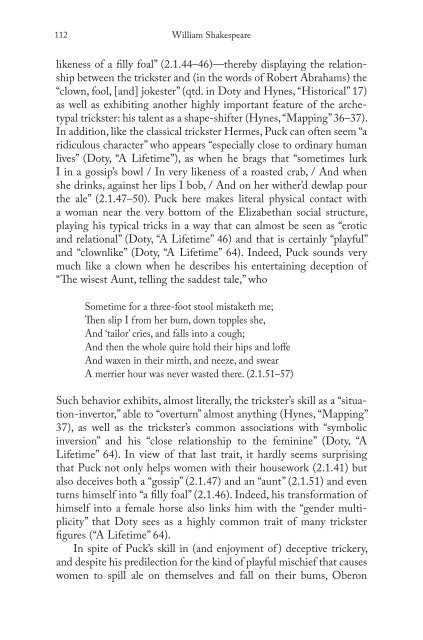Blooms Literary Themes - THE TRICKSTER.pdf - ymerleksi - home
Blooms Literary Themes - THE TRICKSTER.pdf - ymerleksi - home
Blooms Literary Themes - THE TRICKSTER.pdf - ymerleksi - home
Create successful ePaper yourself
Turn your PDF publications into a flip-book with our unique Google optimized e-Paper software.
112<br />
William Shakespeare<br />
likeness of a fi lly foal” (2.1.44–46)—thereby displaying the relationship<br />
between the trickster and (in the words of Robert Abrahams) the<br />
“clown, fool, [and] jokester” (qtd. in Doty and Hynes, “Historical” 17)<br />
as well as exhibiting another highly important feature of the archetypal<br />
trickster: his talent as a shape-shifter (Hynes, “Mapping” 36–37).<br />
In addition, like the classical trickster Hermes, Puck can often seem “a<br />
ridiculous character” who appears “especially close to ordinary human<br />
lives” (Doty, “A Lifetime”), as when he brags that “sometimes lurk<br />
I in a gossip’s bowl / In very likeness of a roasted crab, / And when<br />
she drinks, against her lips I bob, / And on her wither’d dewlap pour<br />
the ale” (2.1.47–50). Puck here makes literal physical contact with<br />
a woman near the very bottom of the Elizabethan social structure,<br />
playing his typical tricks in a way that can almost be seen as “erotic<br />
and relational” (Doty, “A Lifetime” 46) and that is certainly “playful”<br />
and “clownlike” (Doty, “A Lifetime” 64). Indeed, Puck sounds very<br />
much like a clown when he describes his entertaining deception of<br />
“Th e wisest Aunt, telling the saddest tale,” who<br />
Sometime for a three-foot stool mistaketh me;<br />
Th en slip I from her bum, down topples she,<br />
And ‘tailor’ cries, and falls into a cough;<br />
And then the whole quire hold their hips and loff e<br />
And waxen in their mirth, and neeze, and swear<br />
A merrier hour was never wasted there. (2.1.51–57)<br />
Such behavior exhibits, almost literally, the trickster’s skill as a “situation-invertor,”<br />
able to “overturn” almost anything (Hynes, “Mapping”<br />
37), as well as the trickster’s common associations with “symbolic<br />
inversion” and his “close relationship to the feminine” (Doty, “A<br />
Lifetime” 64). In view of that last trait, it hardly seems surprising<br />
that Puck not only helps women with their housework (2.1.41) but<br />
also deceives both a “gossip” (2.1.47) and an “aunt” (2.1.51) and even<br />
turns himself into “a fi lly foal” (2.1.46). Indeed, his transformation of<br />
himself into a female horse also links him with the “gender multiplicity”<br />
that Doty sees as a highly common trait of many trickster<br />
fi gures (“A Lifetime” 64).<br />
In spite of Puck’s skill in (and enjoyment of ) deceptive trickery,<br />
and despite his predilection for the kind of playful mischief that causes<br />
women to spill ale on themselves and fall on their bums, Oberon

















